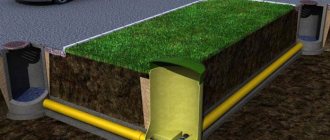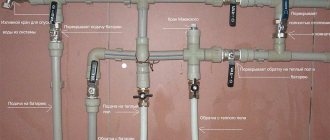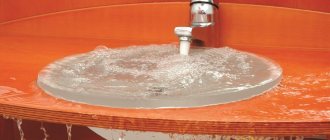If there is a sewer leak in the house, we identify the reasons and begin sealing the drains! So how to seal a leak or seal a joint, first things first.
Sewage pipelines are a free-flow system in which wastewater moves by gravity. Since there is no pressure, the joints do not require particularly strong connections to function properly. This often becomes the reason for too frivolous an attitude towards the quality of connections, leading to the appearance of a bad odor, leaks or other problems. Such cases cause inconvenience not only to the owner of the apartment, but also to neighbors on the lower floors. In any case, when the sewer is leaking, it is necessary to accurately determine the location and cause of the problem. Let's take a closer look at this issue.
Causes of accidents
In the event of an emergency, they begin repairing sewer pipes. Due to the fact that accidents are different, the approach to eliminating them will be different.
If the cause of the damage is mechanical impact, then most likely it will be necessary to carry out a major repair, that is, replace the entire pipe or its element. If the connection is simply depressurized, it will be enough to carry out minor repairs.
The causes of sewerage leaks are most often associated with the occurrence of pipe defects during their manufacture, as well as after the construction of the system - at the joints.
If a sewer pipe is leaking at the junction, you will need:
- dry the joint;
- remove accumulated dirt, cement or glue;
- close the gap between the pipes with linen winding;
- generously coat with construction sealant (more details: “How to seal a sewer pipe - a review of the advantages and disadvantages of materials and methods”);
- wait 5 hours, after which you can start using the sewer.
If it turns out that a pipe is leaking, we will consider what to cover it with, based on their specific situation. If water oozes through a cracked solution, then the cracks that appear after drying will need to be covered with silicone, epoxy or liquid rubber.
If the liquid is leaking through a crack in the pipe, then as a temporary measure, you can drive a small wooden or lead wedge into it, then wrap the damaged area with rubber or bandage and soak it with epoxy or install a clamp. A clamp would be ideal, even if it is homemade.
Whose property is the sewer riser
It should be immediately pointed out that all the sewer lines of the house, which are located outside the apartments (starting from the mine entrances), belong to the common property of their owners (read also the article “Air valve for sewerage - a reliable remedy for various troubles”).
Legislative documents
If pipes leak outside the apartment, utility workers must repair them, without charging additional fees.
- The term “common property” is contained in Art. No. 36 Housing Code of Russia. In addition, in the “Rules for the maintenance of common household property”, which were introduced by the Government of the Russian Federation by its Resolution No. 491 of 08/13/06.
Paragraph 5 of this document indicates that cold and hot water supply risers are part of the common property of the copyright holders of apartments in a residential building.
- As for the sewerage system, its property ownership is determined by paragraph No. 5 of Russian Government Decree No. 354. Below is a quote from this document.
“The common property of apartment owners in a residential building means the building’s drainage engineering infrastructure. It includes sewer outlets, shaped elements, plugs, risers, waste and exhaust pipes, branches of risers to butt joints in apartments.”
Note! Since sewer pipes are common property, they must be maintained and repaired by the company that services your home. Funds for this are taken from the monthly utility bills of apartment owners.
- In other words, the instructions clearly say that you do not have to pay anything extra to your utility companies if a sewer pipe that is located outside your apartment leaks.
What to do in case of an accident
- If your apartment is flooded, write a request to the management company. When there is an emergency, call the emergency service.
Sample Leak Report.
- Employees of these bodies, in the presence of witnesses and interested parties, will draw up a “Leak Report”.
- The document will record which apartments were flooded, indicate the cause of the problem, describe the damaged property, etc.
- This act is extremely important because it names the culprit of the situation.
For example, if it is proven that homes were flooded due to a rotten riser, then the blame will fall on the utility workers. Then the question: “the sewer riser is leaking - who should repair it” should not arise.
When experts determine that the owner of the apartment changed equipment without obtaining permission, or caused mechanical damage to the system, he will be to blame.
Repairing cracks in sewer pipes
Due to temperature changes, small longitudinal cracks may appear on cast iron pipes.
To eliminate this problem, first of all, on the outer part of the pipe, the crack is slightly widened, dried and sealed with sealant. After this, the pipe is wrapped in a heat insulator.
There are cases when water seeps through through cracks.
In this case, eliminating the leak will be as follows:
- the cold welding method with two-component glue is suitable;
- After the glue has dried, we sand the seam, after which it can be painted over.
Conclusion
We looked at the situation when the sewer is leaking - where to go, and also in what cases to solve the problem yourself. As you have seen for yourself, this is quite simple to do (see also the article “Punching a sewer yourself: 3 effective methods”).
The video in this article will complement the information.
Did you like the article? Subscribe to our Yandex.Zen channel
Getting rid of fistulas
Before you fix a leak in a sewer pipe, you should understand how to fix it.
You can use the first method:
- wrap the damaged area with a rubber gasket;
- tighten with a clamp.
There is an alternative method:
- if a large fistula occurs on the pipe, you will need to use a repair coupling;
- cut a piece of rubber to the size of the coupling;
- Tighten it well and the leak should stop.
It is worth noting that special plugs can be found on sale. They are installed in cleaning areas. You can additionally put a rubber gasket on the plug. The solution to sealing a cast iron sewer pipe if the leak continues may be to additionally seal the plug with silicone (pro
Using self-adhesive tape
This material appeared on the construction market relatively recently. It was specially manufactured for processing sewer joints. This sealant comes in the form of a white tape of varying widths wound around a spool. Each manufacturer independently sets the values of this value.
The advantages of self-adhesive tape include the following:
- ease of operation;
- corrosion resistance;
- high insulating properties;
- increased reliability.
Among the disadvantages of this product are instability to ultraviolet rays, as well as the inability to use it for treating open sewers.
If it is necessary to create an airtight connection directly on the street, the place on which this film is glued must be covered with any sun-protective material.
Professionals use this product for other purposes, for example, when they need to create a reliable connection of fittings and other fittings.
Replacing a defective pipe
Often, due to serious damage, it is necessary to completely replace the entire pipe. To do this, you will need to stock up on tools and parts: a hacksaw for metal, flax, pipe wrenches, a sealant, a union nut and a coupling.
The sequence of work will be as follows:
- Using a metal hacksaw, the defective section of the pipe is cut out, plus 30 cm.
- We unscrew all the connections, clean the threads, and remove the cut piece of pipe.
- We make a new thread on the old pipe. To hold it, we use plumbing wrenches.
- We screw the coupling onto the pipe, after which we determine the length of the pipe to be replaced, taking into account the thread (read: “How to properly replace sewer pipes - from dismantling to installation”).
- We fix the pipe in a vice and cut off the required section.
- Using a die we cut a thread on it.
- We wrap flax around the thread and lubricate it with a sealant.
- Using a coupling, we connect the new piece of pipe to the old one.
- At the other end we join the new and old pipe with a union nut.
If emergency repair of a pipe is necessary, it can be wrapped in rubber from a bicycle inner tube and then secured with couplings.
Leak prevention
It is easier to prevent a breakdown than to correct its consequences afterward; toilet leaks are no exception.
To protect yourself from unscheduled replacement of an expensive device, you should follow simple rules:
- regularly inspect the tank and fittings,
- clean the inside of the bowl and tank at least once every six months,
- avoid mechanical damage,
- If water appears on the floor near the toilet, immediately look for its source.
If you find a leak at the bottom of the toilet, don’t grab your head in panic. In most cases, this is a small problem that any DIYer can solve. As a rule, this will require replacing a cheap part, and the work itself will not take even an hour.
Loading…
Repair methods for cast iron pipes
When craftsmen decide how to coat a cast iron sewer pipe, they have several options to choose from:
- wind the strands;
- to settle the strands;
- use asbestos cement solution as putty.
However, before starting any work, the pipe should be cleaned to a metallic shine.
In cases where sewer pipes made of cast iron are morally and physically worn out, they are completely dismantled for replacement.
This work is carried out in several steps:
- using a grinder, cut off a section of pipe to the joint;
- the socket is freed from cement and packing residues;
- the remaining section of pipe is cut with a grinder in several places to make a stop for the lever;
- insert a crowbar into the slots and loosen the pipe along the axis;
- the last piece of pipe is removed from the socket;
- the rubber adapter coupling is mounted in the old socket;
- A new plastic sewer pipe is installed in the adapter.
Types of common types of sealants, their properties, rules of use, pros and cons
In order to make quality repairs and not return to them for as long as possible, you need to choose the optimal method for sealing the seam in the sewer. Each type of sealing material has its own scope of use. In addition, the operating conditions of the system and the economic feasibility of using a particular option should be taken into account.
Types of common sealants
Metal polymers
Metal polymers are an innovative technology for pipe repair. It is also suitable for high pressure pipelines. Sewage systems operate by gravity, without pressure. Therefore, the use of metal polymers is generally not economically feasible. However, in critical areas, in systems operating at the limit of design capacity, the use of this method is justified. In this way you can seal the joint of any sewer pipe.
Use of metal polymer
*
To seal the seam, you need to dry it, clean some area around it, and degrease it. The metal polymer is applied in a thin layer to the entire surface of the joint. On top is a reinforcing component, for example a fiberglass mesh tape. Then a finishing, securing layer of material is applied. To quickly harden, the seam can be heated (if the pipe material allows it).
A sanitary toilet joint insulated using this method will last for centuries. In fact, the seam is put into a permanent capsule made of modern, corrosion- and wear-resistant material.
Cold welding
Cold welding is intended for sealing defects in metal parts or if a sewer pipe has burst. It is not suitable for plastic pipes.
Cold welding is a one- or two-component polymer paste. The consistency is liquid and dense, like plasticine. There are also differences in operating temperature. Because sewer pipes function under normal conditions, cold welding can be chosen at low temperatures, its characteristics are sufficient for the presented task.
Sealing cracks using cold welding
There are compounds that can work in water. In situations where it is not possible to shut off the drain, such welding can be a temporary salvation.
If the work is carried out correctly, the welded joint will be even stronger than the main pipeline materials.
First, the pipes must be completely stripped down to metal, degreased, and dried. To obtain a strong and visually neat connection, experienced craftsmen use liquid compounds. Having thoroughly soaked a piece of cloth with it, tightly wrap the problematic seam. During deformation, the composition begins to “work”, harden, “welding” the parts.
The cost of such repairs is minimal. However, according to reviews from experts and users, this is only a temporary measure that allows the continuation of operation of the sewer system until a more complete or major overhaul.
Ribbon
Sanitary tape will help seal the sewer pipe in the toilet.
It is a multilayer elastic material. It comes in two versions: with and without decorative coating. In any case, the main layer is a bitumen-polymer composition, which is absolutely waterproof and ensures the performance of the tape. At the bottom of this sealant is an adhesive base. The decorative surface additionally protects the tape from negative environmental influences: UV and temperature changes.
Pipe tape
Sanitary tapes have a number of advantages:
- low cost;
- ease of installation;
- reliability and durability;
- ability to work with different types of pipes;
- the tape does not conduct electricity, therefore it is able to protect metal structures from corrosion;
- resistance to environmental influences (with a protective coating).
Tape marked L is for summer and does not lose its characteristics when working at temperatures up to +300 degrees. Winter (marked “Z”) operates in the range of -200...+100 degrees. It is clear that the pipeline will not fall into such conditions in any case. However, when repairing joints outdoors, it is better to play it safe and use winter tape.
Installation of the tape is carried out on a cleaned, degreased area. A well-glued tape is guaranteed to last up to 30 years. The sealant should be wound evenly, avoiding the appearance of bubbles and wrinkles, slightly tighter. In this case, the geometry of the actions is in a spiral, overlapping the previous layer by half its thickness. Thus, at each point of the treated surface there will be two standing sealants. If the tape does not have a decorative coating, the finished connection can be painted with a protective material.
Based on silicone rubber
Sealants based on silicone rubber are favorites when carrying out a wide range of installation work, including plumbing. This is a combined composition that has all the benefits of each component.
Rubber sealants have high viscosity and very good adhesion, which allows you to firmly seal the resulting hole.
Silicone sealant
*
Therefore, they are not so sensitive to the degree of cleaning of the treated area. With high strength, the seam is very elastic. This sealant, like others, has electrical insulating properties, but unlike analogues, it is not sensitive to external influences, so it can be used on plastic communications. Temperature changes over a wide range, high humidity, wind, and exposure to UV rays are not dangerous for a joint sealed with rubber.
Heeled
Kabolka, despite the fact that it is a rather primitive type of sealant, is very popular and is actively used both at home and in professional work. This is a tow or rope, usually made of natural fiber, impregnated with special solutions. To close a crack in the bathroom, the heel is generously impregnated with bitumen resins. This makes its fibers resistant to rotting and drying out, and the pipe connection, covered with a heel, is not subject to corrosion.
Pipe socket
Even a beginner without special knowledge can work with this material: only accuracy and a little effort are required. The price is low and the reliability is good. During installation, it is not necessary to clean and degrease the working area to the same extent as when working with synthetic sealants. That's why heels are so popular.
Technical sulfur
Technical sulfur is sold in lumps or in powder form. It's inexpensive. To work with sulfur as an insulating material, it must be heated to the melting point (130-150 degrees). The substance will turn into liquid resin, which should be used to lubricate the joint of sewer pipes.
To install a pipeline using sulfur, additional equipment is required: containers and heating means. You also need to know how to use it. Another drawback is that in its already frozen form, sulfur is quite fragile, the seam is not elastic.
Thick fabric
A piece of dense fabric can be used as an ambulance for emergency sewer repairs. It must be impregnated with resin or other waterproofing solution and used as a clamp. A harness made of such fabric can replace a sealing gasket.
This repair method can only be used as an emergency when it is not possible to use more reliable and durable materials. The fabric is not resistant to external influences and wears out quickly.











